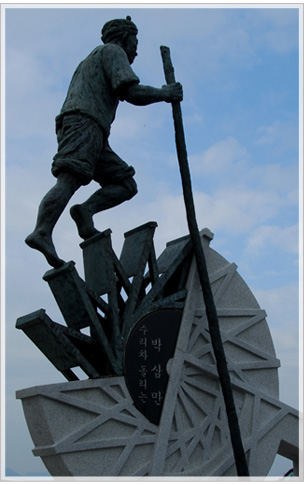
The current Sea Saltern started to be pervasive in Shinan-gun since the making of salterns in Bigeum-myeon, Shinan-gun became successful in 1947. From 1947, Sea Salterns were actively made and by the end of 1950s, as shown in, there were 20 salterns in Bigeum area.
The salterns made in the beginning were Gurim saltern (Gu saltern) of Surim village in Gurim ri, Jidang saltern of Jidang ri, Yongkwang saltern of Yongso ri, Dongjin saltern of Dogo ri, Daedong saltern of Nabae, Gasan saltern of Gasan, saltern 1 and saltern 2 of Surim village, Geumgang saltern of Eupdong, Deoksan saltern of Mangdong, West saltern of Jukrim in front of Sangam village, and salterns in subordinate islands of Gajakdo, Shirangdo, Majado, etc.
In this period, most of the Sea Salterns were made by blocking small-sized embankments in front of the villages and these led the saltern business of Bigeum area in the initial period. Then, they combined with those who acquired the salt-manufacturing skills from Pyeongyang and Incheon and worked in Gurim salter, Jidang saltern, Daedong saltern, etc. and those who produced the salt by boiling in the self-sufficiency level. In 1948, 450 households of Bigeum residents made Daedong saltern guild and created the 100ha saltern. After 5^16, with the currency reform, the value of salt went up high and even laborers in the salterns had so much money and the seams of their wallets would be torn. Thus, Bigeumdo (Bi means fly and Geum means money in Chinese characters) was also understood as 'money flies'.
The saltern space of Bigeum started to have the shape of today from the end of 1970s and was settled in the 1980s. During the 1950~60, the expansion of saltern space was done by private sectors but from the late 1970s, it became part of the national land development project. In particular, from the late 1980s when the first 10-year island-development project started including the work on embankments, docks, lighters wharfs, road expansion/covering business, aiming at 89 islands in the country, the size of salterns was largely expanded.
In Bigeumdo, new embankments were built; Daedong embankment, Shirang embankment, Daeseong embankment, Namil embankment, Jungang embankment, Shinan embankment, Mokdo embankment, Deoksan embankment, Sangam embankment, etc. By expanding the Road 805 connecting Gasan, Eupdong and Docho, the salterns built initially inside the road were converted to rice fields and the saltern spaces were widely expanded outside toward the sea.
Until recently, Bigeum expanded the salterns as shown in, changed its terrain structure enormously, and made the annual income of 10 billion KRW from 226 salterns. The process of making the Sea Saltern of Bigeum was as follows. In Bigeumdo, new embankments were built; Daedong embankment, Shirang embankment, Daeseong embankment, Namil embankment, Jungang embankment, Shinan embankment, Mokdo embankment, Deoksan embankment, Sangam embankment, etc. By expanding the Road 805 connecting Gasan, Eupdong and Docho, the salterns built initially inside the road were converted to rice fields and the saltern spaces were widely expanded outside toward the sea. Until recently, Bigeum expanded the salterns as shown in 〈Picture 2〉, changed its terrain structure enormously, and made the annual income of 10 billion KRW from 226 salterns.
At that time, those who were trying to produce Sea Salt in Bigeum were Bonghun Sohn (73), Samman Park (68), etc. who acquired the saltern skills from Guiseong saltern in Gwangyang bay of Pyeongyang. They already had skills and experiences of saltern production in Gwangyang bay and made a guild with young men in the village. By blocking the mudflats of Surim village, they started to build the trial salterns on March 13, 1946. In the beginning of the saltern construction, the people showed negative responses and the guild members had a hard time surviving the spring starvation period. In the middle of May, the salt production was successful and was reported to the Monopoly Bureau in Mokpo. When this fact was known, 30 residents from nearby set up Gurim 1 Sea Salt-manufacturing guild and built the saltern sized 5-jeong and 8-ban and this is the first saltern in the southwest sea, Gurim 1. Starting from Gurim 1 saltern, Bigeum salterns expanded to Gurim 2 saltern and Jidang 1 saltern. In addition, the salt acquired by boiling down the seawater spread along the Southwest coast was developed into the production in the saltern by making new tidal flats and salterns. A national technical training school for salterns was established in Bigeum elementary school. After that, the saltern development expanded to the Southwest coast and the saltern techniques of Bigeum were disseminated to each region (Shinan Bigeum regional material book, 1999).

